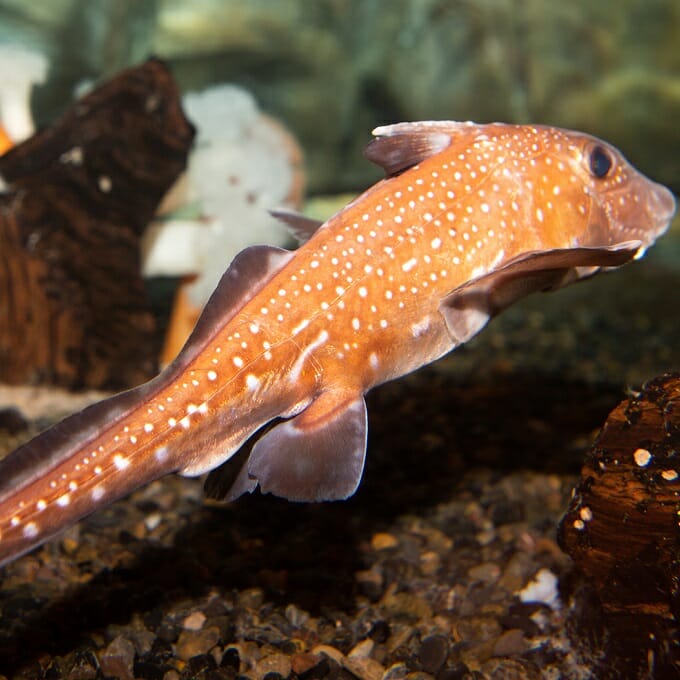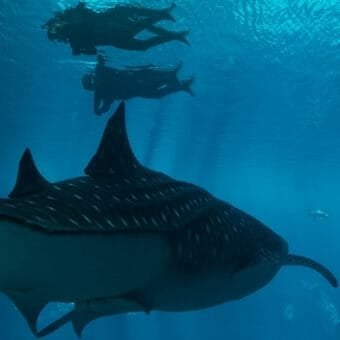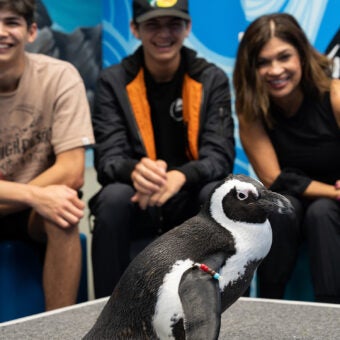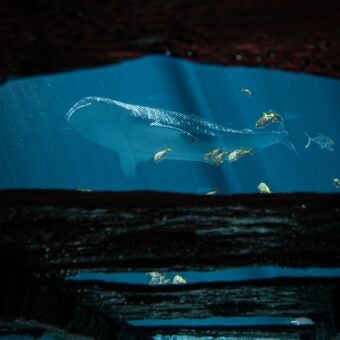-
Size
1-4 feet (30.5-122 cm) -
Diet
Shrimp, clams, worms, sea stars, mollusks and fish -
Range
Every ocean except the Arctic and Antarctic waters -
Habitat
On or near muddy bottoms
Physical Characteristics
- Characterized by a large head and an elongated body that tapers to a whip-like tail.
- Ranges in size from 1-4 feet (30-122 cm).
- Skin is smooth and rubbery lacking any scales or denticles. Bronzy brown on top with large bluish-white spots and silvery on the underside of the body.
- The small and blunt rodent-like snout has teeth formed into three pairs of tooth plates tending to protrude from the mouth like a rodent’s incisors. Hence the common name “ratfish” or ”rabbitfish.”
- Large green eyes and a small mouth.
- Pectoral (side) fins are large.
- Long venomous spine before the first dorsal fin. There is a second dorsal fin that merges with the tapered (caudal) tail fin.
- Sexually dimorphic; males and females are different in appearance. Adult males possess two obvious secondary sexual characteristics: a bulbous or club-shaped knob on top of their heads above the eye and pelvic claspers extending from the posterior edge of the pelvic fins.
Animal Fact
The spotted ratfish defends itself with a venomous spine.
Diet / Feeding
- Diet consists of shrimp, clams, worms, sea stars, mollusks and fish. Uses tooth plates to crush hard-bodied prey such as crabs, clams, and echinoderms.
Range / Habitat
- Occurs in all of the world’s oceans with the exception of Arctic and Antarctic waters.
- Found near the bottom at depths of about 3,000 feet (913 m), usually on or near muddy bottoms.
- Tends to move inshore at night and inhabits shallower water during the spring.
Reproduction & Growth
- At each spawning, the female produces two eggs after internal fertilization.
- It can take her up to thirty hours to extrude her eggs.
- Eggs may hang from the female’s body by long filaments for 4-6 days.
- Once detached from the female, eggs settle on the ocean floor where they take about a year to hatch.
Conservation Status
- “Least Concern” on the IUCN Red List.
Additional Information
- They are considered a missing link between bony fish and sharks due to the characteristics of both classes of fish. Gill openings are like bony fish’s but they reproduce like sharks. Skeletons are made of cartilage, like sharks. These animals are called “chimaera”.
- Often caught accidentally in trawl fisheries.
- One of almost 40 species in Chimaeridae family.
Sources
- www. mbayaq.org/efc/living_species
- www,enature.com/fieldguide/showRguide.asp?rguideID=712&speciesID=3406
- www.fishbase.org
- www.aquariumofthebay.com/spottedratfish.html
- California Marine Life. Snyderman, M., pgs. 98, 99.





